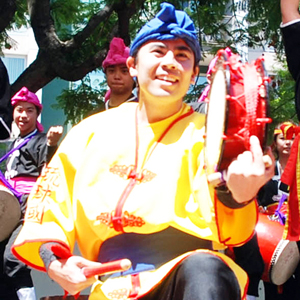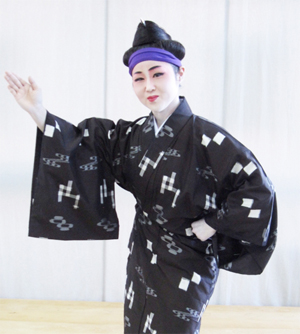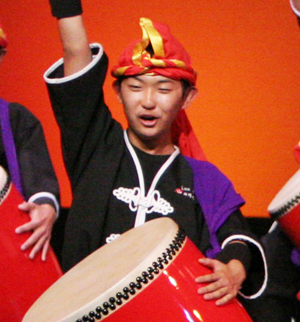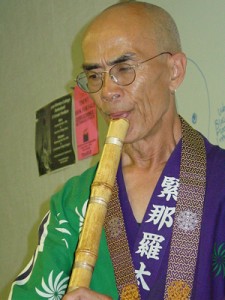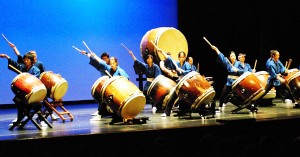2012: Okinawa Association’s folk music and dance activity to mark 25th annivarsary, June 3

A stage of Okinawan folk music by the Okinawa Association's "Geinobu" Performing Arts Committee (Courtesy of the Okinawa Association of America)
The Okinawa Association of America Geinobu Performing Arts Committee is celebrating its 25th anniversary this year at a banquet celebration at the Quiet Cannon, 901 Via San Clemente, Montebello on Sunday, June 3 from 11:30am to 3:00pm.
The deadline to purchase tickets to the 25th Anniversary Banquet is Friday, May 25. Tickets are $35 and for children under 11, $20. To make a reservation, contact Violet Nishihira at (310) 329-1904.
Okinawa Association’s folk music and dance activity attracts younger generation
For the people of Okinawa, folk songs and dance are always a part of their lives. When the immigration from Okinawa to Hawaii and the main-land of the U.S. started at the turn of the 20th century, it was not unusual for Okinawans to bring the sanshin (3 stringed banjo) with them.
Records show that one of the earliest musicians from Okinawa to Southern California was Chusuke Iha. From the age of nineteen, Iha, a native of Chatan village, learned Okinawan music under Master Ryojin Kin. He received his teaching certificate in 1917 and moved to the Imperial Valley where he started farming. He performed his favorite classical pieces at banquets and picnics and sought to spread his knowledge of culture and performing arts.
A high point of the renaissance which occurred in Okinawan musical circles between 1957 and 1970 was the publication of his book, Ongaku no Jitsuso (the True Music), which covers the basic drills in musical intervals and provides a collection of sanshin music.
In the 1980s, Okinawan performing arts circles in Southern California began receiving greater influence from Okinawa when major performing arts organizations in Okinawa started to recognize oversea activities as their own branches.
At that time, Okinawan performing arts included classical music and dance with roots in the Ryuku Kingdom of several hundred years ago.
Within this setting, the Geino-bu, or the Performing Arts Committee, was organized within the Okinawa Association of America in November 1987. Under the leadership of charter president Yasukazu Takushi, a veteran Okinawan classical sanshin instructor, an annual showcase of Okinawan classical and folk music and dance was started at venues of an event facility and a hotel facility.
In the third year, 1989, the stage show Utayabira Wuduyabira (Let’s Sing, Let’s Dance) was produced by Geino-bu in order to present Okinawan traditions not only to members of the Okinawa Association but also to the public. Currently, Utayabira Wuduyabira is held at the James Armstrong Theater in Torrance every other year. The showcase consists of music and dance performances by over 20 studios under Geino-bu.
Geibo-bu, itself, was a driving force to create a youth organization within the Okinawa Association. In 1990, Chogi Higa, then president of the Geino-bu, visited the Koza city (now Okinawa city) mayor to ask his help in starting a youth taiko group which is now Ryukyukoku Matsuri Daiko, Los Angeles branch. Yasukazu Takushi introduced Mr. Higa to the mayor. In 1991, Aiko Majikina, then president of the Geinobu and Majikina Honryu dance instructor, went to Washington, D.C. to observe a stage performance by Ryukukoku Matsuri Daiko (RMD) from Okinawa and made arrangements for the first workshop of RMD in Los Angeles.
Profiles of some distinguished young members of the OAA Geino-bu following:
Ken Yamauchi, 31-year-old
Ken Yamauchi is a postdoctoral fellow at UCLA and researches the mechanisms underlying motor neuron development in the spinal cord. He lives in the South Bay. Both his parents are from Itoman city in Okinawa and were married in Los Angeles.
Currently, Ken is an advisor for the Los Angeles branch of Ryukyukoku Matsuri Daiko (RMD) – an Okinawan taiko group. He started in RMD when he was 15-year-old and has been in the group for almost 16 years.
In answer to the question of why he first joined RMD, Ken says, “I was introduced to Ryukyukoku Matsuri Daiko, Los Angeles branch by Aiko Majikina-sensei and I thought it would be fun. I grew up with a lot of Okinawan culture in my family, such as eating the food, listening to sanshin and watching my sisters perform Okinawan odori, so I felt the desire to participate in something Okinawan.
“When I saw a picture of the Ryukyukoku Matsuri Daiko group in Okinawa and was told about the unique way in which they drum and dance with distinct karate style movements, I wanted to give it a try.”
About his commitment to the Okinawan taiko group, Ken explains, “Now as the advisor for the Los Angeles branch of Ryukyukoku Matsuri Daiko, my motivation is to keep the group vibrant and to pass on my experience.”
Akiko Yamauchi, 27-year-old
Akiko Yamauchi is a legal assistant to a law firm in Los Angeles. Her mother is from Nago city, Okinawa, and her farther is from Koza city, Okinawa. Akiko has lived in Los Angeles her whole life.
Akiko has been practicing Ryukyu Buyo (dance) for 20 years since she was 7-year-old. Currently she is studying under Keiko Yonamine with Tamagusuku-ryu Kanseikai Yonamine Keiko Ryubu Kenkyusho.
Akiko also has performed Ryukyu Koto for 23 years since she was 4-year-old. Currently she is studying under Setsuko Oshiro with Ryukyu Sokyoku Hozonkai.
Akiko explains how she started the lessons, “Both curricular were brought upon me by my mother’s persistence to keep me involved in my culture. But eventually this turned into a passion. Now I strive to stay in touch with my roots to be able to spread the richness and depth of the Okinawan culture.”
To explain her motivation to continue her activities, Akiko says, “I am very intrigued by the depth and beauty of this culture. I feel the deeper your understanding about this culture, the more you come to a realization that there’s no end to it.
“For example, in odori, it is very interesting how your body movements are correlated to the lyrics of the song, not to mention the history behind the origins of the song. Likewise, in Koto as you sing, you feel a sense of connection with our roots.”
About her commitment to the Okinawan performing arts, Akiko says, “I continue these cultural arts not only to spread and expand one’s knowledge about the Okinawan culture but for myself as well; knowing who I am and knowing my roots I feel is very important to my identity.”
Joseph Jones, 25-year-old
Joseph Jones has been in the banking industry for the past 6-1/2-years. He lives in Rancho Bernardo in the San Diego area. His mother was born on the island of Hama-Higa in Okinawa, and he was raised in California.
Joseph has been learning Ryuku Buyo under Keiko Yonamine with Tamagusuku-ryu Kansenkai Yonamine Keiko Ryubu Kenkyusho for 19 years since he was 6-1/2-year-old.
When asked why he started buyo, Joseph says, “My mother used to take dance lessons from Yonamine Keiko sensei and encouraged me to do so. It felt very natural for me to continue even after my mother did not.”
To explain his motivation to continue his dance, he says, “I feel the need to preserve an art that is very important to the people of Okinawa and to the Issei who have immigrated here. Diversity is what keeps our culture and the culture of our world, interesting. I would also like to spread the presence of Okinawan dance and help others understand its roots and depth.”
Kohki Nishioka, 18-year-old
Kohki Nishioka is a student at El Camino College in Torrance. Kohki has been involved with Ryukyukoku Matsuri Daiko, Los Angeles branch for 13 years, since he was 5-year-old.
To provide the reason for first starting the taiko lessons, Kohki says, “Because my parents want me and my sister to learn more about our Okinawan culture and since RMD rehearsals were so close to my place, we decided, ‘Why not?’ ”
To explain his motivation to continue the practice, he says, “While I was young, I hated going to practice. As I got older, I started getting a lot more comfortable with taiko and lots of new members joined so it was nice not being the youngest one there.”
